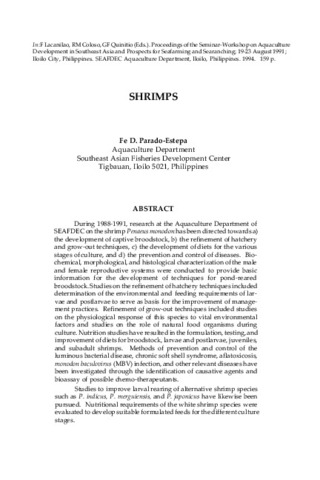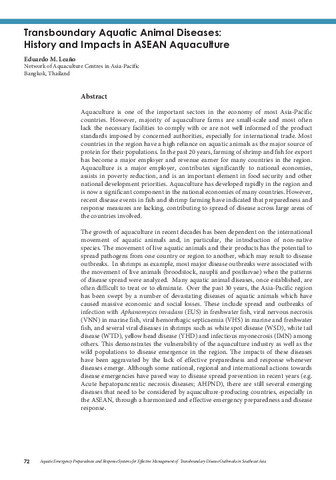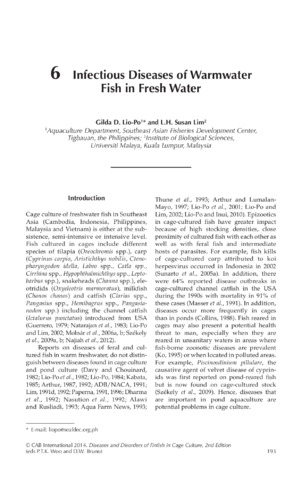Shrimps
- Global styles
- MLA
- Vancouver
- Elsevier - Harvard
- APA
- Help

Date
1994Author
Page views
7,888ASFA keyword
AGROVOC keyword
Taxonomic term
Metadata
Show full item record
Share
Abstract
During 1988-1991, research at the Aquaculture Department of SEAFDEC on the shrimp Penaeus monodon has been directed towards a) the development of captive broodstock, b) the refinement of hatchery and grow-out techniques, c) the development of diets for the various stages of culture, and d) the prevention and control of diseases. Biochemical, morphological, and histological characterization of the male and female reproductive systems were conducted to provide basic information for the development of techniques for pond-reared broodstock. Studies on the refinement of hatchery techniques included determination of the environmental and feeding requirements of larvae and postlarvae to serve as basis for the improvement of management practices. Refinement of grow-out techniques included studies on the physiological response of this species to vital environmental factors and studies on the role of natural food organisms during culture. Nutrition studies have resulted in the formulation, testing, and improvement of diets for broodstock, larvae and postlarvae, juveniles, and subadult shrimps. Methods of prevention and control of the luminous bacterial disease, chronic soft shell syndrome, aflatoxicosis, monodon baculovirus (MBV) infection, and other relevant diseases have been investigated through the identification of causative agents and bioassay of possible chemo-therapeutants.
Studies to improve larval rearing of alternative shrimp species such as P. indicus, P. merguiensis, and P. japonicus have likewise been pursued. Nutritional requirements of the white shrimp species were evaluated to develop suitable formulated feeds for the different culture stages.
Suggested Citation
Parado-Estepa, F. D. (1994). Shrimps. In F. Lacanilao, R. M. Coloso, & G. F. Quinitio (Eds.), Proceedings of the Seminar-Workshop on Aquaculture Development in Southeast Asia and Prospects for Seafarming and Searanching; 19-23 August 1991; Iloilo City, Philippines. (pp. 32-39). Tigbauan, Iloilo, Philippines: Aquaculture Department, Southeast Asian Fisheries Development Center.
Type
Conference paperISBN
971851127XCollections
- ADSEA '91 [21]
Related items
Showing items related by title, author, creator and subject.
-
Country status of aquatic emergency preparedness and response systems for effective management of aquatic animal disease outbreaks in Myanmar
Oo, Kyaw Naing; Cho, Yi Yi (Aquaculture Department, Southeast Asian Fisheries Development Center, 2019)Myanmar is one of the OIE members and the Department of Fisheries (DoF) is highly concerned with transboundary aquatic animal pathogens. Therefore, the Aquatic Animal Health & Disease Control Section has already been ... -
Transboundary aquatic animal diseases: History and impacts in ASEAN aquaculture
Leaño, Eduardo M. (Aquaculture Department, Southeast Asian Fisheries Development Center, 2019)Aquaculture is one of the important sectors in the economy of most Asia-Pacific countries. However, majority of aquaculture farms are small-scale and most often lack the necessary facilities to comply with or are not well ... -
Infectious diseases of warmwater fish in fresh water
Lio-Po, Gilda D.; Lim, L. H. Susan (CABI Publishing, 2014)This chapter presents the viral, bacterial, pseudofungal and parasitic diseases in cultured warm freshwater fish. Focus is given on the distribution, causative agent, pathology, diagnosis, prevention and control of these diseases.






